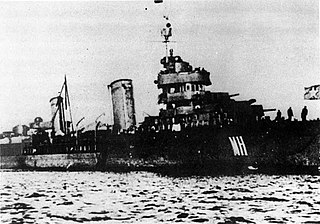 W
WThe six Leningrad-class destroyer leaders were built for the Soviet Navy in the late 1930s. They were inspired by the contre-torpilleurs built for the French Navy. They were ordered in two batches of three ships each; the first group was designated Project 1 and the second Project 38. These ships were the first large vessels designed and built by the Soviets after the October Revolution of 1917.
 W
WBaku was one of six Leningrad-class destroyer leaders built for the Soviet Navy during the 1930s, one of the three Project 38 variants. Completed in late 1939, the ship was assigned to the Pacific Fleet. About a year after the German invasion of Russia in June 1941, she was ordered to join the Northern Fleet, sailing through the Arctic Ocean. Together with several other destroyers, Baku left the Soviet Far East in July 1942 and arrived off Murmansk three months later where she began escorting convoys, mostly in the White and Barents Seas. The ship was badly damaged in a storm that sank another Soviet destroyer in November and was under repair for several months. Baku spent most of the rest of the war on convoy escort duties, although she did bombard several German-occupied towns during the Petsamo–Kirkenes Offensive of October 1944. The ship and her crew were awarded the Order of the Red Banner in early 1945 for their performance during the war.
 W
WKharkov was one of six Leningrad-class destroyer leaders built for the Soviet Navy during the 1930s, one of the three Project 1 variants. Completed in 1938, she was slightly damaged during the Raid on Constanța a few days after the German invasion of the Soviet Union on 22 June and covered the evacuation of the Danube Flotilla to Odessa the following month. During the Siege of Odessa and the Siege of Sevastopol in 1941–1942, the ship ferried reinforcements and supplies into those cities, evacuated wounded and refugees and bombarded Axis troop positions. Damaged by German aircraft a few weeks before the surrender of Sevastopol on 4 July, Kharkov was under repair until the beginning of August.
 W
WLeningrad was the lead ship of her class of six destroyer flotilla leaders built for the Soviet Navy during the 1930s, one of the three Project 1 variants. Completed in 1936, the ship was assigned to the Baltic Fleet and played a minor role in the Winter War against Finland in 1939–1940. After the start of Operation Barbarossa, the German invasion of the Soviet Union in June 1941, Leningrad covered minelaying operations, laid mines herself, and provided naval gunfire support to Soviet units. She escorted ships during the evacuation of Tallinn, Estonia, in August and then bombarded German troops during the Siege of Leningrad. The ship was assigned to evacuate Soviet troops from their enclave in Hanko, Finland, in November, but was badly damaged by mines en route and forced to return to Leningrad for repairs. After they were completed, Leningrad resumed shelling German positions and continued to do so until the Leningrad–Novgorod Offensive drove them away from the city in January 1944.
 W
WMinsk was one of six Leningrad-class destroyer leaders built for the Soviet Navy during the 1930s, one of the three Project 38 variants. Completed in 1939, the ship was assigned to the Baltic Fleet and played a minor role in the Winter War against Finland in 1939–1940. After the start of Operation Barbarossa, the German invasion of the Soviet Union in June 1941, Minsk covered minelaying operations and provided naval gunfire support to Soviet units. She escorted ships during the Soviet evacuation of Tallinn, Estonia, in late August. The ship was sunk by German dive bombers on 23 September, although her wreck was salvaged in 1942 and repaired. Minsk was recommissioned in 1943 but the repairs were not completed until the following year. The ship was reclassified as a training ship in 1951, then became a target ship in 1958 and was sunk that year.
 W
WMoskva was one of six Leningrad-class destroyer leaders built for the Soviet Navy during the 1930s, one of the three Project 1 variants. Completed in 1938 and assigned to the Black Sea Fleet, she participated in the Raid on Constanța on 26 June 1941, a few days after the beginning of the German invasion of the Soviet Union. After the ship had finished bombarding targets in the port, she was sunk by a mine.
 W
WTbilisi was one of six Leningrad-class destroyer leaders built for the Soviet Navy during the 1930s, one of the three Project 38 variants. Completed in 1940, the ship was assigned to the Pacific Fleet, with which she spent World War II. Tbilisi laid minefields outside Vladivostok early in the war and during the Soviet–Japanese War transported naval infantry in preparation for an amphibious landing in Korea. Postwar, she continued to serve with the Pacific Fleet and began a lengthy overhaul in 1951 that lasted until 1955. Converted into a target ship in 1958, she was finally struck from the Navy List in 1964 and scrapped.